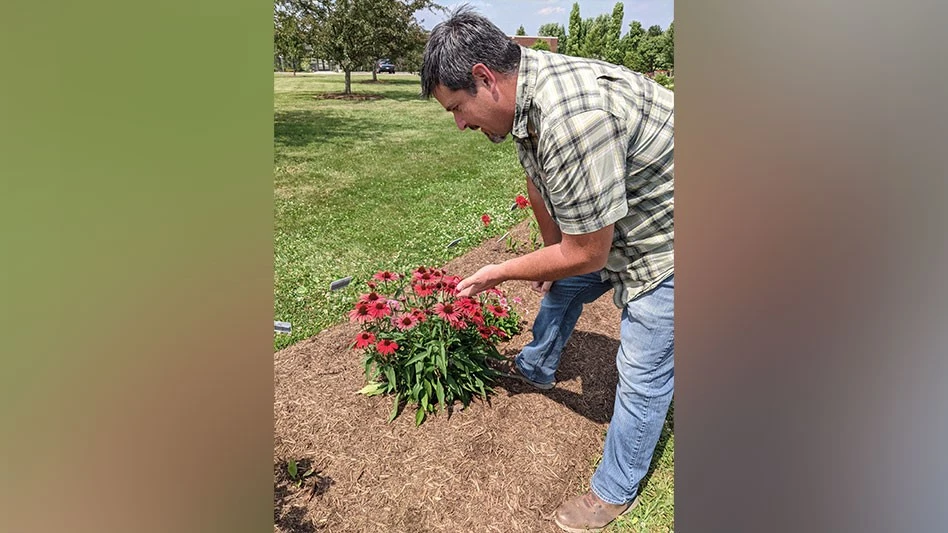
Jason Veil examines the coneflower trials at Secrest Arboretum.

NM: Where did you get started in horticulture?
JV: I used to work for Alan Jones at Manor View Farm for years, until I went and did a few other jobs, went to grad school and now I’m here. But Baltimore is my old stomping grounds. Alan is an innovator, one of those voices in the industry.
NM: How do you see the role of the arboretum?
JV: Horticulture is an art, a science and a business. I think of Secrest as the crossroads where it all comes together. Growers, industry, the public through education. I like to think of us as a really slow-moving zoo.
NM: What was a tough call you had to make as curator?
JV: This is sort of bittersweet, but rose rosette disease took hold of our 50-year-old Rose Garden. When you can’t sustainably grow something, you have to start thinking about throwing in the towel. Because when a Rose Garden looks like our Rose Garden did five years ago, it’s not helping anybody. I use the lemons and lemonade notion that you’ve got to do something with the space. This lends itself perfectly to trials. It’s accessible, it’s laid out really well and we can do lots of different plants in side-by-side evaluation.
Once we ripped the roses out, we said ‘Now what?’ I’ve been in the industry for 20-plus years. You keep your finger on the pulse of what people are buying. And coneflowers have just gone bonkers with breeding in the last 15 years. Twenty years ago you had Magnus, White Swan, Kim’s Knee High. That was about it. And now I’ve got over 100 here. It was a fairly inexpensive, high-impact way to take people’s minds off the fact that the roses are obliterated. Roses are sentimental to people. When people hear that a Rose Garden is being destroyed it breaks their heart. Even though they had no idea that this place was a disaster.
NM: How do the trials help the industry?
JV: With any plant sales and marketing, inertia plays such a big role. ‘This is what we’ve sold, so this is what we will offer.’ And the big gripe from people like me and anybody who’s a plantsman or plantswoman is that we wish that they would carry different things. Or we wish that landscapers would use this variety because it’s better than the old dog that they’ve been using for 40 years. But with adventure comes risk, right? With creativity and experimentation — and we’re talking about dollars and cents when you’re a supplier or grower or a landscaper — they’ll say ‘I don’t want to take a bath because I can’t sell 50 of these,’ or ‘I have to replace it if it dies because I haven’t grown it before.’
NM: How do you break out of that mindset?
JV: There are plants that are so spectacular and they’re so hyped that they become the new go-to and the old ones fade away, but with crabapples there just isn’t that mass appeal anymore. Maybe Maria [Zampini] is going to change that [with the addition of three crabapple varieties to the Proven Winners Ornamental Trees program]. We’ve got a couple of her new plants here, but I think putting a crab in a white pot is a start. It’s part of the conversation again.
NM: What are some of your favorite parts of your job?
JV: Before the tornado, there was a big white pine so it was shady here. And all these hostas went in, and now they just suffer. So slowly, I’ve been ridding this place of hostas where they don’t belong, and trying to backfill with more appropriate things. It’s like I get to paint. I do the same thing at home, but I get to do more of it here.
NM: What are some of the ways you try to educate visitors?
JV: When I started here, we invested in a laser engraver. Labeling is really key. Because if people walking through here look at a plant and leave without knowing what that plant is, you’ve failed to fulfill your mission as an arboretum. At that point, we’re just a park.
For more: secrest.osu.edu

Explore the August 2022 Issue
Check out more from this issue and find your next story to read.
Latest from Nursery Management
- John Ruter shares UGA's latest woody and herbaceous ornamental plant breeding projects
- Conor Foy joins EHR's national sales team
- Pantone announces its 2026 Color of the Year
- Syngenta granted federal registration for Trefinti nematicide/fungicide in ornamental market
- Get to know Kayela Aeppli
- HILA 2025 video highlights: John Gaydos of Proven Winners
- Q&A with Justin Bartlett
- Be the best choice





